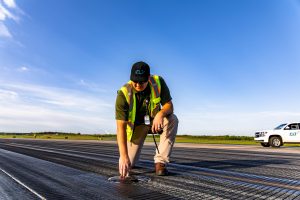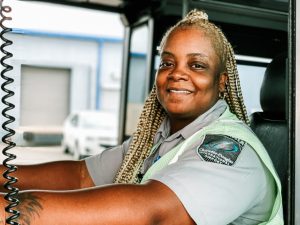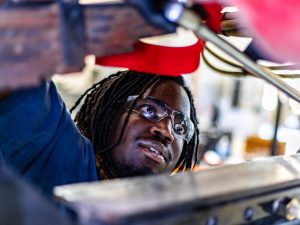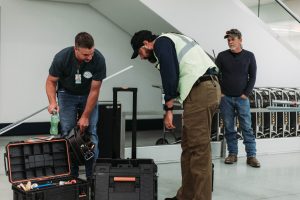The Work Never Stops for Airside Ops
CLT is much quieter with fewer staff and passengers, but those on the airfield and in the control room stay vigilant as they work to maintain safety and keep the Airport operating.

Brian Zoeckler
Airside Operations is one of many essential employee groups working onsite at CLT. Other essential groups onsite are IT, Maintenance, Facilities, Development and Security. Despite some changes to staffing and schedules, Airside Operations must stay focused on what needs to be done.
“We’re still working 12-hour shifts. I’ve altered my schedule to work half of the week. We’re splitting our weeks on Wednesdays,” said Brian Zoeckler, a senior supervisor for Airside Operations.
There are 52 Airside Operations employees. Currently, they are divided into 12-hour shifts that each include one supervisor, five officers and two agents.
There is less airfield traffic, which allows more time for airfield walks and inspections. “We’re just more careful with what we do and where we go,” said Tonya Tucker, an airside operations officer.
She and her co-workers are social distancing, sanitizing their hands and work areas and following other CDC recommended precautions to protect themselves and others from the spread of COVID-19. Though schedules and staffing have changed, Tucker said she still works with a similar size group as she typically does. “We have a pretty good group of people that’s very supportive,” she said.
The workgroup has had to adapt to being effective with as few people necessary on a shift, said Airport Operations Director Lexie Farmer.
“What this means is we have to be very cognizant of how we do the work we do. This means making sure to remain compliant with all regulations and getting everything done that usually needs twice as many people to do,” she said.
Thunderstorms the evening of April 12 knocked out power on the Airport’s south side and put the smaller teams from Airside Operations, Security and Facilities into emergency mode. Runway 18C/36C and Taxiway E were closed, while Operations and Maintenance worked to restore power. Security meanwhile made sure to have a presence at the access points out of service. Field Maintenance repaired an issue in the airfield lighting vault that restored power and lights. The Control Room and Airside Operations kept CLT stakeholders up to date.
The group stays busy whether there are storms or a COVID-19 pandemic is going on. Their responsibilities haven’t changed, and they continue to be onsite for safety issues and to ensure a safe environment, Operations Manager Jeff Perry said.
“We’re not having as many airplanes in and out as we typically do. We’re taking advantage of that by doing safety area walks and getting out on the runways,” Perry said.
Words of encouragement and care packages filled with hand sanitizer and personal care items are some of the ways they thank staff members and keep spirits up. Farmer said the team is looking for other ways to show appreciation for the staff.
Zoeckler looks forward to getting back to the normal workday flow and being able to see everyone in Airside Operations again.
“With telephone conference calls and not seeing everyone every day it is kind of hard,” he said.
Amid the Crisis, Shuttle Drivers Stay Positive
It can be a challenge to stay positive amid so much uncertainty. Yet our shuttle bus drivers are doing just that every day. They are one of several work groups within Landside Operations keeping the Airport going strong.

Ebony Leach
Bus drivers, dispatchers, supervisors and ground transportation officers are all members of Landside Operations currently working onsite at CLT. By their side are Landside Manager Valerie Boston and Assistant Landside Manager Samantha Singh.
“The hardest thing is we’re fighting against something we really can’t see. If you got it, you may not know,” said shuttle bus driver Ebony Leach. “Normally I would have a bus load every time I picked up passengers at the terminal, and now it’s really light, maybe one or two people might get on.”
Staying safe and keeping spirits up are a big part of a driver’s job every day. Now it’s even more important with the uncertainty of COVID-19. The Airport is considered an important part of the nation’s transportation network, and it remains open and operational.
“We have seen a dramatic reduction in passenger travel (but) the buses are getting cleaned and sanitized after each shift,” Singh said.
Along with increased cleaning, passengers and drivers are asked to maintain safe social distance. A plastic chain inside buses helps create a barrier between drivers and passengers, who are asked to get on and off the bus from the rear door. Staggered shifts provide further protection and employees are alternating working one week and being on call the next.
Currently, 40 people in Landside Operations are assigned to work onsite in daily or weekly rotations. All but 10 are shuttle bus drivers. The remainder are on call or working from home. The number of buses on the road has decreased from 50 or 60 to 25 or 30. A parking reconfiguration has moved passengers and Airport workers to parking facilities closer to the terminal.
Driver Lillie Duncan said many people remain positive, happily greeting each other and offering words of encouragement despite the change all around them. “It’s quiet here, but everybody’s in good spirits.”
Being less busy and working staggered shifts has allowed Duncan to get more rest and reduce stress. “I’m reading the Bible because we’re not as busy, and we’ve got the time. That lifts my spirits up because I know that God is protecting us,” she said.
Driver Victoria Gary looks forward to life around the Airport returning to something more normal. “I miss my day-to-day customers,” she said.
Gary enjoys chatting with riders. While there aren’t as many right now, she still tries to give the few people she sees some words of encouragement and reassurance that things will be better soon.
Gary said she is grateful for all the precautions taken to keep the buses and CLT Center clean and safe for employees and the public. “For upper management to even consider doing that for us really means a lot to me,” she said.
Singh and others in Landside Operations are thankful for their staff and the work they are doing in the current climate. They were essential before, and more so today.
“We are eternally grateful,” Singh said. “We have a lot of gratitude for all of the front-line employees and all the essential employees.”
Facilities Maintenance Keeps CLT Moving
Dividing crews and changing up schedules are some ways those in the Facilities Maintenance division are working to keep operations going as the world faces the COVID-19 pandemic.
 The division maintains various Airport facilities. As one of our largest work groups with 180 people, it is comprised of Airfield Maintenance, Building Maintenance, Fleet Maintenance, Logistics and Facilities Services.
The division maintains various Airport facilities. As one of our largest work groups with 180 people, it is comprised of Airfield Maintenance, Building Maintenance, Fleet Maintenance, Logistics and Facilities Services.
“It’s been challenging for us because we’ve had to separate our groups,” said Field Maintenance Manager Chad Huskins.
Throughout the division, crews have been split into A and B teams. While some sections have divided their A and B teams by days of the week, others such as Building Maintenance, alternate their A and B teams each week with one team working onsite while the other works from home.
“It’s difficult to be at home and see what’s going on,” said Randy Garrell, deputy building maintenance manager. To help, there are regular phone calls among supervisors to stay updated about what’s happening.
“We still have to have people here running the facilities. Even if we completely close down and there were no airlines at the Airport, we would still have to have people here,” said Chris Hazen, the Facilities Maintenance Division director.
Keeping everything going these past weeks has led many in Facilities Maintenance to go above and beyond their usual job duties. A few weeks ago for instance, a tree fell across Wilkinson Boulevard blocking all three West Bound lanes. Building Maintenance pitched in with Field Maintenance to help move it.
“It was kind of all hands-on deck. It took them about three hours, but they were able to get the tree removed from the road,” Hazen said.
Over in Fleet Maintenance, Scott Kincaid, the Fleet Maintenance manager, said his group has stepped up when it comes to their work. Usually much of their daily duties involve refueling and maintenance on the Airport’s shuttle buses. With less passenger traffic because of COVID-19, there are fewer buses to work on. As a result, they have been able to turn their attention to other priorities like ARFF equipment and Field Maintenance equipment maintenance and repairs.
The team, which used to focus on fueling buses have taken on the additional responsibility of cleaning and sanitizing the buses. Kincaid’s group also has been able to finish other projects they would normally take longer to complete. For instance, just before the pandemic started, they received 15 trucks to prepare for use by Airfield Maintenance, Security and Development.
“It would take us about three months to get those trucks built and ready for service, but due to the reduction in the number of buses running, we were able to get all those trucks built and ready for service in the past five weeks,” Kincaid said.
To keep spirits up as they continue working hard onsite, many in Facilities Maintenance look forward to the future and their daily lives getting back to normal.
“This too shall end,” has become a common mantra for those in Building Maintenance.
“It’s (the COVID-19 pandemic) not going to go on forever, we’ll get back to some level of normalcy,” Garrell said.
IT: Always There to Help
Balancing work and home life has become a daily juggling act for those in the IT workgroup.
While some have worked exclusively from home the last few weeks, others have alternated working on and off site. The Information Technology team has about 27 employees. In addition to TechHelp, Tech Infrastructure team members are also working on site.

Angelica Huey
“Our assistance may be needed at any time, and we are here to help,” said Angelica Huey, a TechHelp supervisor.
Her work since the COVID-19 pandemic started has been similar to what she did previously. The main difference is who she sees every day. The IT workgroup recently implemented contactless assistance, which helps prevent possible exposure to COVID-19 by reducing face-to-face interaction among team members and other employees.
“The biggest challenge is uncertainty because the virus isn’t seen or heard,” Huey said.
To stay safe, she wears a mask, makes sure to social distance and follows other recommended guidelines. To help release stress, Huey said she listens to music, goes for walks and prays.
“We have weekly WebEx meetings to coordinate projects onsite and critical or essential projects that need to move forward,” Technology Director Rich Adkins said.
Currently, the IT workgroup is divided into Teams A, B and C. Team C works from home and comes in only if necessary, while teams A and B report onsite, alternating weeks, or work a hybrid schedule based on business need, to provide critical project support and essential services.
To help keep team member spirits up and to check in with everyone, Adkins encourages weekly non-work focused half-hour group meetings. During these meetings, the staff are encouraged to discuss a variety of topics such as projects they’re working on at home, special talents or any new hobbies.
“It’s just a time to connect with other people on the team,” Adkins said. “This helps us stay connected during this event. It helps folks work better together.”
Contractors working with the IT group are also feeling the effects of the pandemic.
“Everything is different because I don’t get to interact face to face with co-workers anymore,” said Rider Perez, a TechHelp technician and contractor. “ I can’t go to the terminal unless it is business related, and I must do everything remote these days. This pandemic has led us to support users over the phone, email and online. The human touch of our job is completely gone for now.”
Despite this, he and others in IT onsite and at home work to stay positive.
“I try to tell people that this crisis is not going to last forever,” he said. “We’ll eventually go back to normal.
Security Team Adapts to Change, But Mission Stays the Same
The work of Airport Security has not changed because of the pandemic, but the environment has for the 87 people who comprise the group that includes security officers, locksmith operations and the credentialing office.
“The atmosphere of the Airport and feeling has changed significantly,” said Security Operations Officer Ryan Symonds. “The passenger flow is down, which lowers the amount of Airport employees, which results in our department having fewer security related issues to respond to.”
 Helping stop the spread of COVID-19 and keeping safe is something Symonds and fellow coworkers take seriously. Deep cleanings and wipe downs of public and high-touch areas occur regularly at CLT. He and his coworkers make sure to use hand sanitizer and personal protective equipment as well as follow Aviation Department and CDC guidelines on social distancing.
Helping stop the spread of COVID-19 and keeping safe is something Symonds and fellow coworkers take seriously. Deep cleanings and wipe downs of public and high-touch areas occur regularly at CLT. He and his coworkers make sure to use hand sanitizer and personal protective equipment as well as follow Aviation Department and CDC guidelines on social distancing.
“I wear a mask when I’m in the terminal and responding to calls, and in my personal life, I mask up when I go get supplies,” said Security Operations Officer Tayler Caudle.
Safety is the No. 1 priority all the time in this work group where staggered shifts have been in place for about six weeks now.
“It doesn’t matter if there’s one person in the Airport or 40,000, it’s all the same rules,” said Renee Tufts, security operations manager. “It’s business as usual keeping our patrols up, compliance measures in check for the Airport security program and keeping the badging and access control system going.”
Also keeping things going is Chief Locksmith Chris Picerno. He and his team of three locksmiths may not come to mind when thinking about Airport Security, but their task is to maintain locks all over the terminal and CLT Center and ensure the right people have access to doors they need.
“It’s challenging to get our jobs set up and installed, but we’re managing,” Picerno said. “Our schedules have changed drastically. We now have a locksmith on property seven days a week.”
He along with a new employee work Monday through Friday. A third person in the group works Sunday through Tuesday while another works Thursday through Saturday. They alternate on-call duties on Wednesday.
Bringing new employee Darryl Campagna up to speed in the middle of the pandemic presented challenges, Picerno said. Campagna started March 30.
“His orientation was web-based and very abbreviated. It was difficult getting everything he needed because other departments are on alternate schedules as well,” Picerno said. “His training also has gone slower as we need to practice social distancing.”
The team in credentialing and badging are social distancing too. Usually packed with people applying for and renewing badges, the office is now more quiet. There are 50 percent fewer people. Many tenants have furloughed and laid off employees, so some badges have been deactivated.
“We’re trying to be as flexible and accommodating as possible with our stakeholders so we can keep the number of returning badge holders we have to rebadge down,” Tufts said. “That’s why we’re dealing with every impacted stakeholder on a case-by-case basis.”
COVID-19 has forced many changes in the Airport and how employees go about work and daily life. Many of these things will likely live with us for a long time, Picerno said.
Social distancing, washing hands frequently, using hand sanitizer, and wearing a mask have become habits.
All stories written by Lacey Hampton and photographed by Jason Paul, members of the Charlotte Douglas International Airport Strategic Communications Team.

